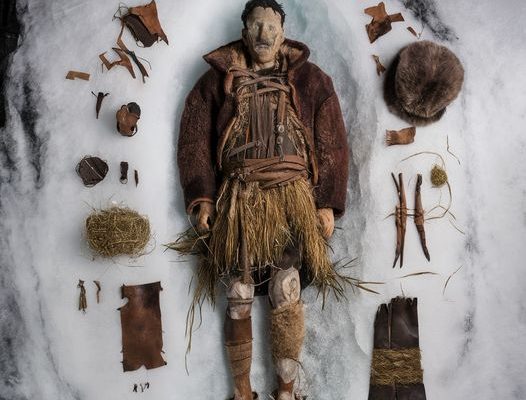In 1991, high in the Ötztal Alps on the border between Austria and Italy, a discovery was made that would forever change our understanding of prehistoric Europe. A well-preserved mummified body was found encased in ice, later named “Ötzi” after the region where he was discovered. Ötzi’s remains were determined to be over 5,000 years old, dating back to between 3400 and 3100 BCE, making him one of the oldest and most well-preserved human mummies ever found.
Ötzi’s preservation was a result of a natural mummification process caused by the cold and dry conditions of the glacier where he had been buried. When archaeologists and scientists began examining his remains, they uncovered an astonishing amount of information about his life, health, and death. His body had dehydrated in the ice, but his skin, organs, and even his tattoos were still visible, providing a wealth of details that allowed researchers to piece together the life of this prehistoric man.

Alongside Ötzi’s body, numerous artifacts were found that shed light on the technology and craftsmanship of his time. These included fragments of leather, string, hide, and braided grass, which were later identified as parts of his clothing. Ötzi had been dressed in a coat, belt, leggings, loincloth, and shoes, all made from animal hides and grass materials. He also wore a bearskin cap, further indicating his reliance on natural resources to survive in a harsh environment. His shoes, which were highly sophisticated for the time, were padded with hay to provide insulation against the cold.
Ötzi’s belongings, found scattered around his body, revealed much about his lifestyle and possibly his final moments. He carried a copper axe, an incredibly rare and valuable item for that period, a flint dagger, and a long stick that was identified as part of a bow. In addition, he had a quiver with two finished arrows and 12 arrow shafts, indicating that he was either hunting or preparing for some kind of conflict. Two birch-bark containers were also discovered, one of which contained traces of maple leaves and charcoal fragments, which may have been used for carrying embers to start fires.
Perhaps one of the most intriguing aspects of Ötzi’s body was the 61 tattoos found on his skin. These tattoos, in the form of lines and crosses, were not made with a needle like modern tattoos, but by making small incisions into which powdered charcoal was rubbed. Researchers believe these tattoos may have had a therapeutic purpose, possibly related to pain relief or healing practices, as many of the tattoos were located on parts of his body that showed signs of wear or illness, such as his lower back and joints.
Despite the wealth of information gleaned from his body and possessions, the circumstances of Ötzi’s death remain one of the most fascinating mysteries. X-ray examinations revealed that Ötzi had a flint arrowhead embedded in his left shoulder, and the entry wound was found in his back, indicating that he had been shot from behind. The arrow had shattered his shoulder blade and caused significant damage to blood vessels and nerves, suggesting that he likely bled to death. Additionally, Ötzi had a severe head injury, though it’s unclear whether this was caused by a fall after being shot or a blow to the head during a separate altercation.
Other clues point to Ötzi having been involved in a violent encounter days before his death. A deep cut on his right hand suggests that he may have been in a fight or defending himself from an attacker. Despite these injuries, he had continued to travel through the Alps, indicating that he was likely fleeing or pursuing something in the final days of his life.

At the time of his death, Ötzi was about 45 years old, stood 160 cm (5 ft 3 in) tall, and weighed around 50 kg (110 lbs). He was relatively healthy for his time, though his teeth were heavily worn down, likely due to the coarse diet of grains and plants he consumed. Further analysis of his stomach contents revealed traces of various grains, fruits, and meats, providing insights into his last meals.
Ötzi’s body and the artifacts found with him are now housed at the South Tyrol Museum of Archaeology in Bolzano, Italy, where they continue to be studied and displayed to the public. His discovery has not only deepened our understanding of the people who lived in Europe during the Copper Age but also provided a unique glimpse into the daily life, health, and challenges faced by prehistoric humans. Ötzi’s tattoos, clothing, weapons, and injuries all offer invaluable clues about his life and the broader culture of the time, making him one of the most important archaeological finds of the 20th century.



